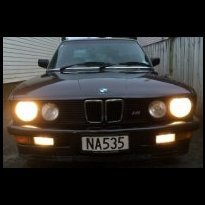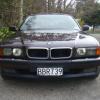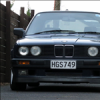Leaderboard
Popular Content
Showing content with the highest reputation on 01/29/17 in all areas
-
3 pointsUpdate #7 Yesterday Dad, a friend of mine James, and I made some more progress - specifically working on RACP reinforcement. We did some investigation, and decided that we'd first try manufacturing our own reinforcement plates, see how difficult it was/how good the end product was, and then decide whether to put them on, or go for an out of the box solution. Turns out making our own wasn't as difficult as we were anticipating... We're manufacturing with 2mm steel plate, with the intention of epoxying the plates. Epoxy is a necessity on the two rear mounts, as they had the structural foam inserted by BMW some years ago. We were unsure as to whether we would weld or epoxy the front plates, but have settled on epoxying those as well, to get full adhesion across the entire surface. In addition to this, on the front right mount (which had cracks in it) we will do the following: Drill and weld the cracks (done) Cut through from the top to check that the bolt carrier hasn't detached from the upper layers of the RACP (and fix if it has). Structural foam for the front two mounts. All of those measures in combination should be sufficient to remediate the existing damage, and prevent damage from reoccurring. I don't intend to track the car or do anything else that is likely to cause extreme stress to the RACP. I'll have to monitor it over time, but I expect this work to vastly improve the current situation. We started by firstly cleaning the underbody protection and paint off the entire surface area of the RACP that we're going to reinforce, and then we used thin cardboard to make a template of each surface we want the plates to cover. For the rear mounts this resulted in a set of templates that looked like this: We then transferred the templates onto the sheet steel (this pic show's only one of the elements of the rear plates): We used the plasma cutter and cut each rough shape out, cutting outside of the markings. (note this is a different part to the above photo!): We then cleaned up each piece on the bench grinder, using the marked template to show where to clean the edges to. There was a little bit of back and forth, making minor adjustments so that the pieces all fitted and sat correctly, then we held the pieces in place, and tack welded them in place: This resulted in something that looks like this: Next steps on this example are to brace it, weld the joins and clean the piece up. Once that's done, the various holes that need to be drilled will be done, and the piece should be ready for fitting. The other rear plate is a mirror image of this one, with a couple of extra holes drilled in it for various cable brackets. The two front ones are unique, as one has more scallops in it than the other. Overall I was pleasantly surprised at how easy this whole process was. Going into it I wasn't sure what our end product would be like and whether the fitment would be exact enough, but it's turned out very well indeed. :thumbsup2: Next steps are to finish the other brackets and weld and clean them up. In other news, we've been continuing to clean pieces up for painting. Had one of my orders from Pelican Parts turn up the other day. Another in transit, and the last one is pending a couple of not in stock items before it ships. Till next time :parrot:
-
1 pointmy mate recently brought a 2001 740i msport , needed the timing chain and guides doing he just got a kit in from the usa approx. $500usd also brought the cam locking tool in got my other mate a mobile mechanic to do the job took him about a day and half etc
-
1 pointinteresting , why did you do the rings and bearings ?? head gaskets? ?
-
1 pointAdmire your great attention to detail. If you need advice or a repair kit for the subframe cracks give us a call.We had 40 kits of our own design made about 2 1/2 years ago and have 5 left. That means there are 35 E46`s out there with or reinforcement without any problems.
-
1 pointUpdate #5 Today was bushings removal day! First up were the subframe bushings. During the week Dad had welded up a removal tool. Basically the same concept as the official tool. One end of the tool straddles the subframe surround, around the bushing. A high-tensile threaded rod goes through the bushing, and a plate on the other end of the bushing covers the end face of the bushing. Tighten up the nuts on each end and the bushing is pulled out. Here's a pic of the tool (complete with demonstration bushing): And here it is in action: We basically followed the TIS procedures for the various bushings. The tools that we made for this job mirror the official tools in the way that they work. As you can see in the second photo, we also heated the subframe bushing cages as per the TIS procedure (600C for up to 2 minutes). Following this process the bushings came out in a reasonably straightforward manner. A fair amount of force needed (as you can see by the design of the tool). Here's one of the bushings after removal. Not in terrible condition, but also not as great as the new ones going in. And here's the subframe, free of the 4 main bushings. :rockband: Next up was the front diff bushing. Again, a very similar approach here. Just had to make sure we were accurate with the plate that cups the bushing, so that it was small enough to fit into the channel in the subframe, but large enough to cover the outer casing of the bushing. Here's the tool mid-production: Dad driving his MIG welder, with plasma cutter in the background. Note that without this equipment (and a parent, or other acquaintance of your choice, who knows how to drive them), manufacture of said bushing removal tools would be very difficult. And here's a couple of shots showing how the tool fits up. Note that after these photos were taken, testing proved that we needed to do double-thickness 10mm bar on the crossmember (like the subframe bushing tool) to provide sufficient bend-resistance. Goes to show just how much force is involved. That cross member is 70mm long, and ended up needing to be 20mm thick to take the forces involved! I didn't actually take any photos of the diff mount bushing during/after removal, but rest assured that we got it out fairly easily. We celebrated with lunch (which I didn't photograph, and won't show you, cause this is a car forum, not Instagram). After lunch (which has already taken up too many words in this journal), we moved on to getting the bushings out of the inner ends of the upper and lower control arms. We spent a while on this. The issue wasn't a mount for the side of the tool the bushing was being pulled towards, we were able to just use a large socket and some steel bar spacers for that (no need to weld up a tool), the issue was finding/manufacturing something the right size to cup the end of the bushing that was being pulled. We messed around with a few designs that we ended up abandoning, because we were in danger of flaring the ends of the aluminium sleeves on the bushings. We then tried just washers, and pulling only the inner core of the bushing, and letting it pull through the rubber. Again, in spite of a lot of force, we weren't able to make it budge even a little bit. At this point we consulted TIS procedure (and this awesome DIY: http://www.m3forum.net/m3forum/showthread.php?t=464146) and determined that we were on the right track, and just needed to apply more force!!! We wound it back up again, added a pipe extension to the breaker bar, wrapped the whole arrangement in welding gloves in case of catastrophic failure, and just kept cranking. Eventually it gave way, and, once it moves, it's fairly straightforward from there. No photos of this bit unfortunately, we were a bit focused on not getting hit by flying bits of metal. But basically you just need more force. You have to get to the point where you cannot believe how much force is involved, and then go a few turns beyond that, and that turns out to be enough to make it move :thumbsup2: Here's a photo magically showing the bushing removed: We tried the same approach with the lower control arms (using spacers to keep the two halves of the arm with the correct separation). We succeeded in moving the bushing somewhat, but there was so much force involved, and we had zero confidence in being able to reverse the process to get the new ones in, that we decided to cut our losses and buy new arms, which already have the bushing pressed in. At $50 each it's a pretty good deal, and given these are fairly lightweight parts, it's probably good to put new ones on (at least that's what we told ourselves as it got closer to dinner time). Having already removed the trailing arm bushings a week and a half ago, that brings bushing removal to a closure for us. It's great to have got them all out. It's been really surprising just how much force is required to get the old ones out. Certainly without the ability to manufacture your own tools to get this job done, it would be either very messy and frustrating, or a costly process to get the bushings out. Tomorrow will be a slower day. It's terrible weather here at the moment, so I'll limit myself to more clean up of the exhaust section 1 and 2. Over the next few days Dad is going to clean up more parts for painting, and will paint as well if the weather starts playing ball and provides something less that 100% humidity. Over and out for now.
-
1 pointI could get down to 7.2 from my 328i on the open road so that seems plausible.
-
1 point





